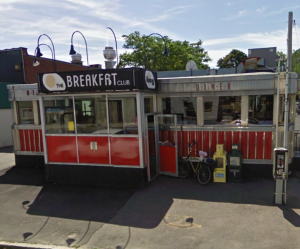The design of your communication must be on par with its content
This past June, I was attending my son’s lacrosse tournament. We wanted a down-to-earth place to eat breakfast. The locals recommended a nearby diner. Now you know what a diner looks like: silver façade, booths with plastic seats, counter and stools, coffee machines and blenders and that little window into the kitchen, slightly cramped. You can picture it, right? Sounded perfect, so we went.
 We walked in and looked around. Lots of people, but no waitresses. After a few moments, the swinging doors from the kitchen popped open. Out walked an elegantly dressed man, tux and bow tie, replete with cummerbund and gleaming black shoes. He approached, bowed, and said in a proper tone, “Good morning gentlemen. Have you a reservation?” I raised my eyebrows. “Apparently not,” he intoned flatly. “Fortunately,” he said in a brighter tone, “we’ve just had a cancellation. Please, follow me.” Turning crisply, he walked toward an empty booth. After we sat, he pompously handed us each a stylish menu. Then addressed me formally: “Could I interest you in our reserve wine list? A crisp white would prove a fanciful accouterment for this lovely Sunday morn.”
We walked in and looked around. Lots of people, but no waitresses. After a few moments, the swinging doors from the kitchen popped open. Out walked an elegantly dressed man, tux and bow tie, replete with cummerbund and gleaming black shoes. He approached, bowed, and said in a proper tone, “Good morning gentlemen. Have you a reservation?” I raised my eyebrows. “Apparently not,” he intoned flatly. “Fortunately,” he said in a brighter tone, “we’ve just had a cancellation. Please, follow me.” Turning crisply, he walked toward an empty booth. After we sat, he pompously handed us each a stylish menu. Then addressed me formally: “Could I interest you in our reserve wine list? A crisp white would prove a fanciful accouterment for this lovely Sunday morn.”
Confused? Well, if this had been reality, we would have been too. When you walk into a diner, you expect things a certain way. But not this way. To put it another way, this diner’s look did not match its content.
A more pertinent perspective. A long, long time ago (in a galaxy far away), I was approached by a software company to work on their documentation. The docs were basic reference and how-to manuals, describing their menu and explaining their function. They were written by an engineer—who also had a penchant toward inserting references to popular cultural philosophies and weaving their ideologies into the text. Interesting since this ersatz writer-engineer took pains to make the context of these fairy tales relevant; most ended up mild rants.
Management at the company felt that customers were not using the guides because they were out of date, needing and update to match the current software version. Okay, I said, let me look at them.
Let’s say that the guides were, hmmm, typographically and design challenged. I was presented with a relatively tall stack, about two dozen guides. Three-hole punched. Courier 12 point headings and text. All single spaced. All grey.
“What about a redesign too?” I gently suggested. “Perhaps part of the problem,” I continued, “is your customers can’t find anything in the guides, so they don’t use them.”
They thought about that a moment, then, to their credit, they accepted. What would it cost? How long would it take? Because they were releasing another version of the software soon, they wanted the guides to match. The entire redesign and writing took a year, but we completed them all. And they turned out great.
Perception is paramount. As with the look and feel of a diner, the design of your documents—be they technical, promotional, training, web, reports, proposals, essentially all communication materials—directly affects how they are perceived and received. And used.
Okay, so these are egregious examples. Here’s the point: To be effective, your documents—instructional, promotional, and technical, as well as your web pages, request-for-proposal responses, reports, customer correspondence, essentially all written communication—must meet the demands of document design.
Document design brings together text, graphics, layout, and typography to inform, instruct, and persuade. In our work for the software company, we also incorporated elements that identified the company and helped with product recognition. In other words: branding. We endeavored to be subtle, not overwhelming, but apparent.
Engage your audience. Superior document design compels your audience to engage in your communication.
The effective design of written communication, whether practical or promotional, takes a discriminating eye and intelligent, deliberate design. Document design’s goal is to successfully present information without getting in the way. In other words, design itself, by its very nature, must be all but invisible.
Effective document design requires more than type selection and spacing and color and imagery. It requires a thorough understanding of your audience and their needs: how they will perceive the communication, process its content, assimilate it, and ultimately use it. The fundamental purpose of document design is not to simply “look pretty”, win awards, call attention to itself, nor showcase the designer’s skills, but rather to meet your needs. It must enable people to learn, use technology, make decisions, and ultimately, get their jobs done.
Put another way: a reader’s needs must ultimately drive document design. And when they do, the resulting design moves you closer toward humanity in communication.
—Rich Maggiani
Karl Schweitzer 22 September 2011 @ 6:40 pm
Aloha Rich – you hit it on th nail. It is all about the customer / consumer needs not managment’s needs.
KS
Robert Hershenow 22 September 2011 @ 6:49 pm
Nice job, Rich. Thanks for another insightful post. I’m with Karl on this – it’s all about the user. And transparency is so important. Ideally the user/reader/learner is completely unaware of the design, and hears only the message it delivers.
Rebecca 25 October 2011 @ 8:44 pm
Wow. Stunningly crafted and informative, too!